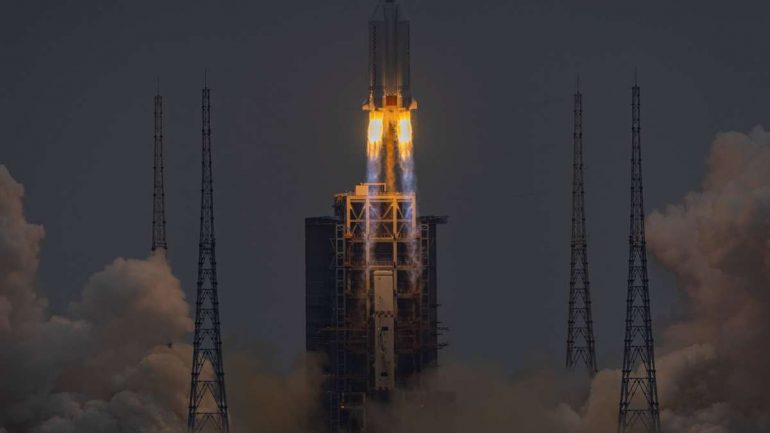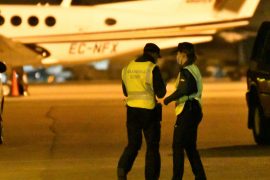-
OfTanja banner
shut down
A Chinese rocket stage weighing 21 tons crashed towards Earth. When and where it will hit is still unclear.
Update Wednesday, May 5, 2021, from 9.30 am. Will the Chinese rocket component, which will bring the first module of the new Chinese space station into space, uncontrollably return to Earth? It is currently orbiting the Earth, but its orbit is falling. There have been two calculations so far when the rocket will enter the Earth’s atmosphere in an uncontrolled way. “Space Track” predicts an uncontrolled re-entry between 2:00 pm on 8 May and 8:00 pm on 9 May.
The “aerospace company” has calculated a large time window for the crash: between 1:00 pm on 8 May and 9:00 am on 10 May. These calculations will be further refined in the coming days – but there is one thing they will not be able to do until shortly before the end: correctly determine the accident site. The rocket is still moving too fast for him.
Chinese rocket: Space debris uncontrollably falls towards Earth – crash site unclear
BEIJING – The news made headlines in late April: China has launched the first module of its own space station, while the end of the International Space Station is clearly approaching. Just a few days after the introduction of the “Tianhe” module, the Chinese mission made headlines again – but this time for the negatives: the rocket stage that orbited the first module of the space station, currently falling uncontrollably on Earth is.
| Rocket stage weight | 21 tons (excluding fuel) |
| Rocket stage size | 30×5 m |
| Speed | 25,200 km / h |
| Height of the earth’s orbit | 165 to 326 km |
| Class inclination | 81.5 grad |
Uncontrolled re-entries into the Earth’s atmosphere occur about 50 to 60 times a year, which estimates Spacenews.com to Holger Krag, the head of Esa’s space security program. However, the rocket stage of Changzheng-5B (“Long March”) is heavier than any part that has crashed uncontrollably since the 1990s. Astronomer and space observer Jonathan McDowell explains, “Since 1990 nothing more than 10 tons has been intentionally left uncontrollably into Earth’s orbit.”
A part of a Chinese rocket falls to the ground uncontrollably
The Chinese rocket stage weighs about 21 tons without fuel, about 30 meters long and five meters wide. When it re-enters Earth’s atmosphere, most rocket phases are likely to burn – but not all of it. Experts suspect that about 20 to 40 percent of the mass may survive entry. These parts then crash on Earth – when and where it is actually very difficult to predict, among other things because the rocket phase is traveling very fast. It is currently orbiting the Earth at a speed of 165 to 326 kilometers at a speed of seven kilometers per second (25,200 km / h), orbiting the blue planet once every 90 minutes.
Atmospheric friction slows the Chinese rocket stage more and more, the rocket loses altitude and will crash sooner or later. You can’t calculate exactly where the parts of the rocket will fall, but at least you know a corridor on Earth in which the rocket will crash. The Chinese missile has an inclination of an orbit of 41.5 degrees, meaning it will crash somewhere between 41.5 degrees north and 41.5 degrees south. On the border of this corridor are cities such as New York, Madrid, Barcelona, Rome, Istanbul, Beijing and Wellington – but the corridor also has a number of uninhabited areas and seas. “In the worst case scenario, it would be like the crash of a small airplane, which spans hundreds of kilometers,” McDowell told the German press agency.
Missile falling from China can hit in populated areas
The remains of Chinese rockets are more likely to fall into the sea or in uninhabited areas. But it is also possible that the falling rocket stage is hit in the inhabited areas. It is very difficult to predict: if the forecast is only five minutes away, the rocket has already flown more than 2000 kilometers away. Many parameters flow into calculations that are not entirely clear: how soon will the rocket lose altitude and crash? How much mass will be left from re-entry? One thing is already certain, however: Germany will not hit the Chinese missile – the country is far north.
Most of the rocket’s stages return to Earth at some point. Private space company SpaceX, for example, is the first stage to land a “Falcon 9” rocket on Earth or a drone ship to reuse it. However, most rocket stages are brought down in a controlled manner – they then crash, for example in the South Pacific. There is the so-called “spaceship cemetery”, an area that is very remote and from where the nearest country is more than 2000 km away. Among other things, the Russian Mir space station was sunk there, and more than 260 spacecraft found their end there.
Further Space news Can be found on our subject page.
China: “Tiangong-1” space station also crashed uncontrollably
The largest uncontrolled crash of a space object ever was the 1979 crash of the 90-ton American space station “Skylab”. The accident had to be controlled, but the calculation was not quite accurate, so that pieces of the space station fell down the Indian Ocean and Western Australia. The first Chinese space station “Tiangong-1” also crashed uncontrollably in 2018. Part of the 8.5-ton space station that did not burn fell into the sea near Tahiti. The successor space station “Tiangong-2” was brought under controlled accident in 2019.
The space station that China is currently building is called “Tiangong” and is expected to be much larger than its predecessor. A total of eleven space flights are planned. It remains to be seen whether the rocket stages will again crash uncontrollably after completion of their tasks. Space Observer McDowell is not enthusiastic about the falling Chinese rocket stage in any case: “I think, given the current standard, it is unacceptable for the rocket stage to crash uncontrollably.” (Tanja Banner)

Introvert. Proud beer specialist. Coffee geek. Typical thinker. Pop culture trailblazer. Music practitioner. Explorer.






